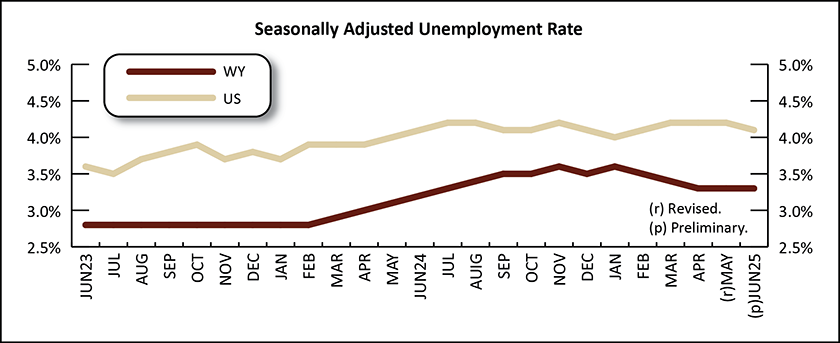Wyoming Labor Force Trends
August 2025 | Volume 62, No. 8
Click Here for PDF
Return to Table of Contents
Wyoming Unemployment Steady at 3.3% in June 2025
by: David Bullard, Senior Economist
The Research & Planning section of the Wyoming Department of Workforce Services reported that the state’s seasonally adjusted1 unemployment rate held steady from May to June at 3.3%. Wyoming’s unemployment rate was just barely higher than its June 2024 level of 3.2%, but much lower than the current U.S. unemployment rate of 4.1%.
From May to June, most county unemployment rates followed their normal seasonal pattern and increased. Unemployment rates often rise in June as young people get out of school and start searching for work. The largest increases occurred in Albany (up from 2.6% to 3.4%), Big Horn (up from 3.9% to 4.7%), Carbon (up from 3.5% to 4.3%), Converse (up from 3.1% to 3.9%), Fremont (up from 3.6% to 4.4%), Goshen (up from 3.3% to 4.1%), and Sweetwater (up from 3.5% to 4.3%) counties. Teton County’s unemployment rate fell from 3.0% in May to 2.3% in June as the summer tourist season got into full swing.
From June 2024 to June 2025, unemployment rates rose in every county, suggesting that the supply of labor has increased compared to a year ago. The largest increases were seen in Goshen (up from 3.0% to 4.1%) and Niobrara (up from 2.7% to 3.7%) counties.
In June, the highest unemployment rates were found in Big Horn County at 4.7% and Fremont County at 4.4%. The lowest rates were reported in Teton County at 2.3%, Crook County at 2.7%, and Johnson County at 3.0%.
Current Employment Statistics (CES) estimates show that total nonfarm employment in Wyoming (not seasonally adjusted and measured by place of work) rose from 301,100 in June 2024 to 305,400 in June 2025, an increase of 4,300 jobs (1.4%).
R&P's most recent monthly news release is available at https://doe.state.wy.us/LMI/news.htm.



 Hire Wyo
Hire Wyo